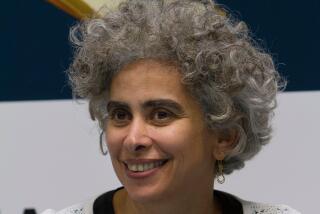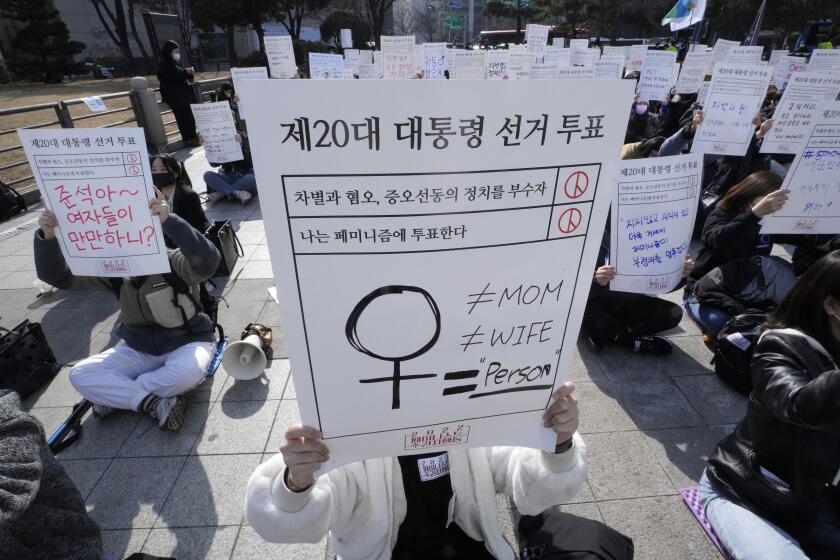Expo 2000 May Not Be Fare Attraction, Critics Say
- Share via
HANOVER, Germany — There are no awesome feats of engineering such as the Eiffel Tower or London’s Crystal Palace, no thrills to rival the first Ferris wheel that enchanted visitors to Chicago in 1893.
And needless to say, no songs have been inspired that urge Europeans to “Meet Me in Hanover,” site of the Expo 2000 world’s fair that opens Thursday.
What the biggest planned event in the 50-year history of modern Germany does offer is a detailed presentation of the world’s environmental problems and practical lessons on how to resolve them.
But is a strictly serious education--at the price of $32 per person--enough to compel the hoped-for 40 million visitors to head for this wind-swept provincial trade town decidedly lacking in charm and fun? Will exhibits explaining a natural pulping process or how paper cups can be made into pencils keep kids entertained in the glaring absence of rides and amusements?
Organizers insist that they are satisfied with the fair’s attractions, but pollsters and pundits already are raining on Hanover’s parade. They predict that the five-month extravaganza will cost German taxpayers far more than the $185 million they are already expected to lose.
This week’s Der Spiegel magazine reported the results of a survey by the prestigious Emnid Institute in which 54% of 1,000 Germans interviewed said they were absolutely certain to skip Expo 2000. An additional 34% were doubtful they would go, although the bulk of attendance is expected to come from the host country.
German media also disclosed this week that only 20,000 tickets had been sold for Thursday’s gala opening--a far cry from the nearly 300,000 visitors a day needed to meet the 40-million forecast. And Deutsche Bahn, the German railroad, acknowledges that the bulk of its expanded service to Hanover is still unsold.
The last such event sanctioned by the Paris-based International Expositions Bureau, or BIE--the 1998 fair in Lisbon--drew only 10 million visitors, leaving organizers and exhibitors alike deeply in debt.
Those responsible for Germany’s first world’s fair have put a brave face on Hanover’s prospects, despite devastating setbacks such as Washington’s last-minute announcement that there would be no U.S. pavilion for the first time since world’s fairs began 149 years ago. Likewise, fair officials have defensively brushed off suggestions that in the age of the Internet and ubiquitous entertainment, visitors to events such as Expo 2000 are becoming harder to impress.
“For those with doubts about world expos, I can tell you they have a bright future. They are not going to be done in by the Internet,” BIE President Gilles Noghes insisted during a media preview of the 420-acre fairgrounds, which take nine hours to negotiate on top of time spent at exhibits.
But other initiators of the Hanover event already are looking for scapegoats before the electromagnetic security gates even open.
Those countries and organizations that anted up millions to show their flags at this fair are “very disappointed” that the United States couldn’t manage to mount a national presence, complained Ole Philipson, head of Expo 2000’s steering committee.
“We’re not happy about it,” said Birgit Breuel, the fair’s commissioner general.
Although there is no U.S. national exhibit, some icons of American culture, such as McDonald’s and Coca-Cola, are everywhere. A handful of private companies with international profiles, including IBM and DaimlerChrysler, have sponsored their own presentations. Carlos Santana, B. B. King and Britney Spears are among the fair’s global palate of entertainers.
Guided by the far-reaching theme “Humankind, Nature, Technology--A Whole New World,” the millennial world’s fair--which has been a decade in the making--focuses on what people and their machinery can do to ease the impact both have on the planet.
Japan’s pavilion is made out of paper and will be recycled at the end of the fair--a fitting culmination of an event intended to highlight renewable resources. One of the British exhibit’s four theme rooms chronicles the Darwin Project that is attempting to collect DNA samples from all the world’s species. The Netherlands’ triple-tiered biosphere--nicknamed the Big Mac--explains the ecology of a forest and allows visitors to inspect the process from roots to treetops.
Some national exhibits have taken a more traditional approach to their presentations, reminding visitors of the countries’ most ingenious inventions and proudest achievements. The German pavilion displays an “ideas workshop,” which offers plaster busts of famous Germans, from Albert Einstein to Steffi Graf, and notable contributions of each of the nation’s 16 states, such as the first Mercedes-Benz motor car from Baden-Wuerttemberg and a Gutenberg Bible press from Rhineland-Palatinate.
The city-state of Berlin is exhibiting a piece of its infamous wall--an unintended reminder of the one truly massive celebration to break out in Germany, when the hated Cold War symbol fell more than 10 years ago.
While organizers insist that attendance will pick up once the European school year finishes and families head out for August and September vacations, those administering some of the most popular pavilions have more modest forecasts.
The French exhibit expects about 6 million visitors through the Oct. 31 conclusion, said Jean-Baptiste Marvaud, an assistant commissioner. British event producer Pip Campbell forecasts fewer than 4 million for a national presentation that traditionally is among the top three attractions at world’s fairs.
Germany’s federal government is footing 40% of the $1.56 billion cost of staging the fair, with local and state governments providing another 40% and German industry contributing the remaining fifth. Income from ticket sales and concessions--based on the 40-million attendance figure--should reimburse all but $185 million of the investment, Breuel assured reporters.
More to Read
Sign up for Essential California
The most important California stories and recommendations in your inbox every morning.
You may occasionally receive promotional content from the Los Angeles Times.














